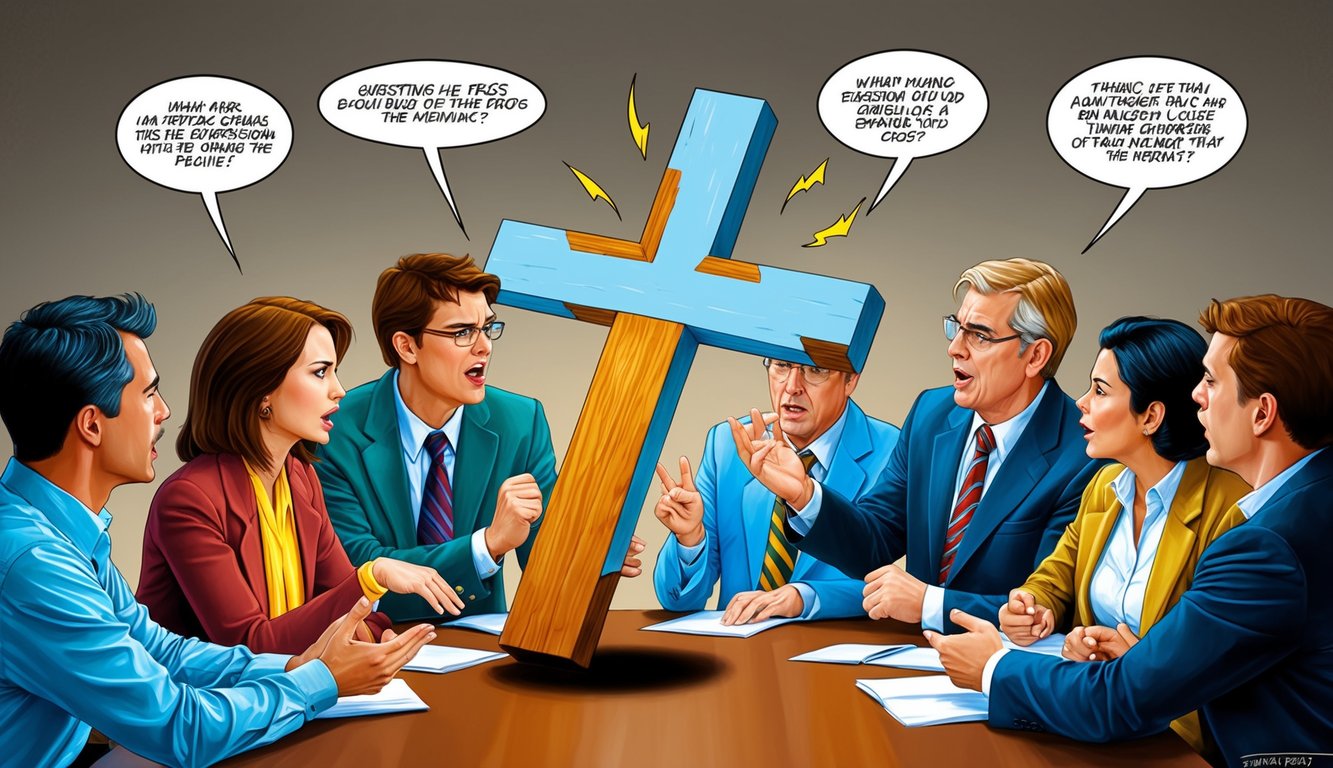Don’t Miss Out On This Unique Astrological Opportunity
Are you tired of spinning your wheels and getting nowhere? Simply put, you’re out of sync: you’re out of alignment with your astral configuration.
But: there’s a kind of map that can help you reclaim your alignment. Think of it as your own personal blueprint to success and happiness: a blueprint that will help you live your most amazing life.
Get started here.
When you come across the image of an upside-down cross, you might wonder about its meaning.
In Christianity, Saint Peter is often associated with the upside-down cross.
According to tradition, Saint Peter was crucified upside down because he felt unworthy to die in the same manner as Jesus.
This symbol is a reminder of humility and faith.
Throughout history, symbols can take on various meanings depending on the context.
While some might mistakenly see an upside-down cross as a sign of negativity, its roots suggest a profound dedication to spiritual beliefs.
Exploring symbols like these can offer insights into the diverse tapestry of Christian traditions and practices.
By understanding the deeper meanings behind such symbols, you can appreciate the rich history and complexity of religious iconography.
This exploration invites curiosity and a deeper connection with the stories that shape faith practices around the world.
The Historical Origins and Symbolism
The upside down cross, also known as the Petrine cross, is linked to St. Peter and has unique meanings within the Christian tradition.
It became a symbol associated with humility and the foundations of the Christian faith.
Early Christian Context and St. Peter
An upside down cross is closely tied to the story of St. Peter, one of Jesus’ apostles.
According to Christian tradition, Peter was martyred in Rome.
By his own request, he was crucified upside down because he felt unworthy to die in the same manner as Jesus.
This act represented humility and deep respect for Jesus.
The cross, known as the Petrine cross, signified a unique humility.
It’s not a sign of disrespect, but rather a representation of Peter’s commitment.
This story highlights the significance of the cross in early Christianity.
It connects with the symbolism of Peter holding the keys of heaven, emphasizing a strong foundation for the church’s teachings.
Adoption into Christian Tradition
Throughout history, the upside down cross has been adopted into Christian iconography.
It serves as a reminder of St. Peter’s dedication and humility.
In some traditions, this cross is seen as a symbol of the Pope, representing apostolic succession from Peter.
Rather than being negative, it reflects an essential piece of Christian heritage.
Today, you might see it in various contexts, like church art or papal emblems.
Its use signifies acknowledging the faith’s origins and honoring St. Peter’s role.
Despite its strong association with humility, the upside down cross often requires context to understand its intended message fully.
Cultural Associations and Misinterpretations
The upside-down cross carries different meanings that vary across cultures and contexts.
It has strong ties to satanism and the occult, shows up in heavy metal and punk subcultures as a symbol of rebellion, and appears in horror films and popular media to evoke fear or intrigue.
Associations with Satanism and the Occult
You might see the upside-down cross linked with satanism and the occult.
This connection comes from its use in anti-Christian symbolism.
Many people associate it with disrespect for traditional religious beliefs, especially Christianity.
Some satanic groups have adopted this symbol as a way to express their opposition to Christian doctrines.
It’s important to note that while it’s often viewed as anti-Christian, not everyone who uses it aligns with these beliefs.
The symbol’s use varies by context and group.
Use in Heavy Metal and Punk Subcultures
In the world of heavy metal and punk, the upside-down cross often symbolizes rebellion and anti-establishment attitudes.
Bands and fans sometimes use it to challenge authority and traditional norms.
You can find this symbol on album covers, stage designs, and band merchandise, where it’s meant to provoke and question societal values.
These subcultures embrace the cross as a sign of individuality and freedom.
It’s more about defiance than religious disrespect, reflecting their members’ desire to stand apart from mainstream culture.
Appearance in Popular Culture and Media
The upside-down cross also appears frequently in movies and television, particularly within the horror genre.
Films like The Conjuring and The Amityville Horror use it to create an eerie, unsettling atmosphere.
It’s meant to evoke fear by implying a presence of evil or the supernatural.
In popular culture, shows and movies sometimes use the symbol without fully exploring its original religious meaning.
It serves as a visual shorthand for rebellion or horror, often playing into dramatic scenes for maximum effect.
Religious Significance and Interpretations

The upside-down cross holds various meanings in Christianity.
It symbolizes both humility and sacrifice, especially in stories related to Apostle Peter.
While some view it negatively, many Christians understand its deeper significance as a reflection of faith and dedication.
Rejection and Humility in Christianity
In Christian faith, the upside-down cross is often tied to the story of Apostle Peter.
According to tradition, Peter asked to be crucified upside down because he felt unworthy of dying in the same way as Jesus Christ.
This act symbolizes deep humility and a commitment to self-sacrifice.
For believers, the upside-down cross serves as a powerful reminder of Peter’s devotion and his rejection of personal glory.
This religious symbol emphasizes one’s willingness to put faith above self-importance.
In Catholic tradition, this interpretation resonates, reminding you of the sacrifices made by early followers of Christianity.
It reflects the ideals of humility and devotion.
The upside-down cross has been adopted as a representation of valuing faith over personal pride, serving as a meaningful icon in various religious contexts.
Contemporary Christian Views
Today, the meaning of the upside-down cross varies among Christians.
While some see it as a positive symbol of humility, others perceive it incorrectly as representing evil or rebellion against Christianity.
Yet, many faithful continue to embrace the symbol’s original context.
It remains a reminder of true sacrifice and dedication to religious values.
In modern Christianity, understanding the upside-down cross can be complex.
Some people mistake it for a sign of anti-Christian sentiment, but within the Catholic Church and broader Christian communities, it stands as a testament to the sacrifices of the early apostles and the commitment to spiritual humility.
This nuanced perspective encourages you to explore beyond superficial interpretations and appreciate its historical and spiritual significance.
Modern Usage and Symbolic Meanings

The upside-down cross often sparks curiosity and debate.
It appears in diverse contexts, reflecting various interpretations, from fashion to expressions of defiance.
Adoption by Non-religious Movements
The upside-down cross has been adopted by non-religious movements as a symbol of defiance and rejection of mainstream beliefs.
Some people use it to express individuality, challenging norms and traditions that they see as restrictive.
It’s not unusual to find it used in artwork and logos as a way to provoke thought and discussion.
This symbol is especially popular among those who enjoy pushing boundaries.
It sometimes appears in tattoos and pendants, representing a personal or philosophical stance.
These movements use the cross’s visual impact to communicate a message of resistance and freedom from established beliefs.
Fashion and Lifestyle Statements
In the world of fashion, the upside-down cross has become a bold statement.
From jewelry to clothing designs, it’s crafted into pieces that catch the eye and start conversations.
Designers often use it to add an edge to their collections, blending traditional symbols with modern style.
Some wear it as a pendant or incorporate it into artwork for its aesthetic appeal.
For many, it’s a way to embody individuality.
Its appearance in fashion shows and lifestyle trends illustrates this powerful emblem’s shift from religious context to a more personal expression.
It is worn by those who want to showcase their unique tastes while connecting with broader themes of rebellion and non-conformity.
Debates and Controversies

The upside-down cross is often surrounded by debates and controversies.
Some see it as a symbol of faith, while others view it as an anti-Christian or satanic symbol, causing diverse reactions.
Religious Perspectives on the Inverted Cross
In religious contexts, the inverted cross is closely linked to the apostle Peter, who, according to tradition, was crucified upside down.
Many Christians view this as a symbol of humility and devotion, honoring Peter’s wish not to equate himself with Jesus.
However, the cross has also been adopted by groups like the Church of Satan as an anti-Christian symbol.
It represents opposition to traditional Christian beliefs and nonconformity.
This dual meaning can lead to confusion and tension between those who see the cross as holy and those who associate it with negative connotations of rebellion or atheism.
Public and Media Reactions
Reactions to the inverted cross can vary widely when it appears in public.
Some accept it as part of religious identity or artistic expression.
Meanwhile, others might view it with suspicion or fear due to its associations with Satanism and the occult.
Media portrayals sometimes sensationalize its use, linking it to controversial themes in popular culture.
This portrayal can influence public perception, turning the inverted cross into a flashpoint for debate, especially in communities sensitive to religious symbols.
The symbol often sparks discussions on freedom of expression, intention behind its use, and respect for diverse beliefs.
These debates reflect broader conversations about the role and interpretation of religious symbols in societal and personal contexts.



